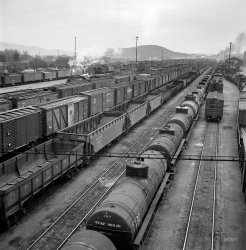
MAY CONTAIN NUTS

Search Shorpy
SHORPY ART

Framed or unframed, desk size to sofa size, printed by us in Arizona and Alabama since 2007. Explore now.
Join and Share
Ad-Free Shorpy
Shorpy is funded by you. Patreon contributors get an ad-free experience.
Learn more.

Recent comments
- Freeze Frame
- Texas Flyer wanted
- Just a Year Too Soon
- WWII -- Replacing men with women at the railroad crossing.
- Yes, Icing
- You kids drive me nuts!
- NOT An Easy Job
- I wonder
- Just add window boxes
- Icing Platform?
- Indiana Harbor Belt abides
- Freezing haze
- Corrections (for those who care)
- C&NW at Nelson
- Fallen Flags
- A dangerous job made worse
- Water Stop
- Passenger trains have right of way over freights?
- Coal
- Never ceases to amaze me.
- Still chuggin' (in model form)
- Great shot
- Westerly Breeze
- For the men, a trapeze
- Tickled
- Sense of loneliness ...
- 2 cents
- Charm City
- What an Outrage
- Brighton Park
Member Photos
The Shorpy
Print Emporium
Print Emporium
Search Shorpy
Search results -- 30 results per page
- Blue Island Yard: 1943
- January 1943. Riverdale, Illinois. "Blue Island Yard of the Indiana Harbor Belt Railroad with view of the icing platform." Photo by Jack Delano, Office of War ... Posted by Dave - 04/15/2024 - 1:33am -
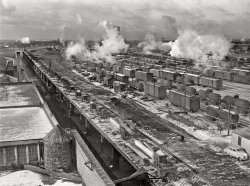
- Galewood Yard: 1943
- April 1943. Galewood Yard of the Chicago, Milwaukee, St. Paul and Pacific Railroad (Milwaukee Road) at Chicago. View full size (if you don't, you're missing a lot). 4x5 Kodachrome transparency by Jack Delano.
This was probably one of This was probably one of thephotos ... Posted by Dave - 08/05/2012 - 9:27am -
![Galewood Yard: 1943 April 1943. Galewood Yard of the Chicago, Milwaukee, St. Paul and Pacific Railroad (Milwaukee Road) at Chicago. View full size (if you don't, you're missing a lot). 4x5 Kodachrome transparency by Jack Delano.
This was probably one ofThis was probably one of thephotos Jack took during a survey of american railroads during WWII for the Office of
War Information (OWI). His work can be found in a great railroad book, the "Iron Horse at War" (out of print).
Delano railroad photosHi Jeff,
Actually, a better place to find the Delano images is to head straight to the Library of Congress' website and doing a search for "Jack Delano". YOu want a full sized image? How about a 200 meg TIFF?
[You won't find anything on the LOC site like our full-size version of the image above. Plus, the LOC images are all uncorrected.- Dave]
RR yardGreat pict, Milw RR had some huge yd in Chicago, of interest would be how they unloaded & loaded the boxcars accross 5 tracks without platforms inbetween them, I bet they used ramps inbetween the cars so they could access them and save a lot of money on constucting many platforms. The cars would be spotted (placed) so the doors would line up with all 5 tracks. Just make sure the switch yd crew would do a good job of lining the cars up. I like the Alton car which looks just recently painted. I wonder if any of this yd is still around.
Galewood YardYes the yards are still there....or were a year ago. I retired from CMSt.P&P RR...I hired out on the Southeastern Division and later transfered to the D&I and worked the suburban trains that ran right past theese yards. and you were correct about ramps...they bridged the distance with very hweavy constructions that were set in plase with forklift.
(The Gallery, Kodachromes, Chicago, Jack Delano, Railroads)](https://www.shorpy.com/files/images/1a34816u.thumbnail.jpg)
- Hybrid EV: 1942
- ... "Chicago, Illinois. One of the Chicago and North Western Railroad streamliner diesel electric locomotives. These trains are operated ... don't charge or operate on batteries (except some at low yard speeds for shuttling).
[You're thinking about this much too ... Posted by Dave - 03/10/2024 - 2:58pm -
![Hybrid EV: 1942 December 1942. "Chicago, Illinois. One of the Chicago and North Western Railroad streamliner diesel electric locomotives. These trains are operated jointly with the Union Pacific Railroad to the West Coast." Acetate negative by Jack Delano, Office of War Information. View full size.
Not hybrid or EV.Locomotives are diesel-electric, not hybrid. The electric part is the method of power transmission between the engine and wheels because they have a 250-950rpm operating range. A gearbox would be too large and complex to be practical, especially when synchronizing multiple units. They don't charge or operate on batteries (except some at low yard speeds for shuttling).
[You're thinking about this much too narrowly. Hybrid: "Of mixed character; a thing made by combining two different elements." - Dave]
Ice BeardJust like old man winter.
Chug and playShorpy is certainly correct - but then almost all (North American) "diesels" are such: a diesel engine drives a generator that powers the traction motors. But the U.P. was strictly an amateur about combining powering methods
The SBB lok is still around - ! - but converted back to free-range capabilities.
EMD E6It looks like the EMD E-series, guessing E6, built from 1938 to 1942.
I take it backThe E-series didn't have the radiator. Lionel offered two streamliners, the M10000 and this thing. I can't find pictures of this thing that also give the model number.
Achoo-choo!It looks like its nose is running! I love that streamlined look, though. I'll bet it's sporting that striking Union Pacific armour yellow and gray paint scheme, too!
Re: Achoo-choo!You are absolutely correct!
Not an E-unit. It's an M-10000!I think that the "runny nose" comes from water in the air hoses. (Just a guess!!)
Steam HeatPassenger cars of the past used steam for heating and, in some cases, for air conditioning too. Steam locomotives had plenty, but diesel electric locomotives needed diesel oil fired auxiliary boilers. The steam is transmitted from locomotive to cars via metal pipes and couplings. In freezing weather, it seemed one could always see whisps of steam here and there - perhaps the valve beneath the pilot (steel plate above the rails) was slightly cracked open to prevent freezing. Once can see minor damage to the pilot - perhaps the locomotive encountered a vehicle somewhere at a crossing.
Only a handful of these machines were built before larger and more powerful locomotives became available. I recall reading that one of these locomotives struck a skunk which splattered over the area where we see the frozen steam. The large, automobile-like grilles, supposedly brought the odor into the cab making things stinky for the crew.
About that runny nose.Water is never permitted in a trains air hose. A frozen brake line is a train wreck looking for a place to happen.
Passenger engines such as this one have (had) a steam generator on board to supply a steam pipe to the entire train for heating, air conditioning, cooking, etc. The ice on the pilot would be condensate from this steam line.
Corrections (for those who care)This locomotive is a Pullman-Standard M-10005 or M-10006, produced in 1936 -- a descendant of the "original" M-10000 from 1934, which was already retired a year when this photo was taken. These were predecessors of the famous EMC/EMD "E" series locomotives produced by EMD starting in 1937.
Additionally, the icicle "beard" was caused by leaking steam from the steam train line -- steam was used to heat (and cool in summer for coaches that had steam-ejector air conditioning installed) the passenger coaches, and was produced by steam boilers on the locomotive. Steam was used on all conventional passenger equipment until the late 1970s when electrical head-end-power (HEP) came into vogue.
(The Gallery, Chicago, Jack Delano, Railroads)](https://www.shorpy.com/files/images/SHORPY-8d11464u.thumbnail.jpg)
- Red Comb Feeds: 1943
- ... Illinois. "Freight operations of the Indiana Harbor Belt Railroad. Grain elevator and mill at a siding of the Harbor Belt's Blue Island Yard south of Chicago." Medium format acetate negative by Jack Delano for the ... Posted by Dave - 04/13/2024 - 9:40pm -
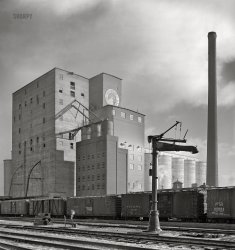
- Icing on the Freight: 1943
- ... January 1943. "Icing platform of the Indiana Harbor Belt Railroad. Blue Island Yard south of Chicago." Acetate negative by Jack Delano for the Office of War ... Posted by Dave - 04/17/2024 - 2:26pm -
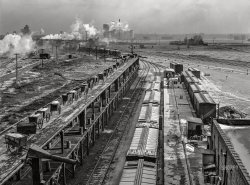
- Proviso Yard: 1943
- Freight cars in the Proviso Yard of the Chicago & North Western Railroad. April or May 1943. View full size. Kodachrome transparency by Jack Delano.
Yellow Rails The rails that appear to be painted yellow ... Posted by Dave - 09/07/2011 - 9:49pm -
![Proviso Yard: 1943 Freight cars in the Proviso Yard of the Chicago & North Western Railroad. April or May 1943. View full size. Kodachrome transparency by Jack Delano.
Yellow RailsThe rails that appear to be painted yellow have a fresh layer of rust on the railheads.
Jack DelanoThanks for all the Jack Delano posts. I stumbled on his work several years ago. You have no idea how happy it makes me to find in Shorpy a fellow appreciator.
- Abraham
[Thanks Abraham! How did you find out about him? Online? He is my favorite of the photographers whose work is on the site. - Dave]
More on Jack DI found him through the Library of Congress' "American Memory" site. It was the railroad stuff -- the portraits, the train barns, the nighttime rail yard photos -- that got me.
Aside from the interview transcript with him and his wife that's in the Smithsonian archives, I don't know much else about him. What was his stuff like after he moved to Puerto Rico?
Jack DelanoThanks for making this site searchable by photographer; it's the best single collection of Delano's images I can find on the web. Delano's photos are my favorite from the post-1930's period: unsentimental but still saying a lot. You might be interested to know that his son, Pablo Delano, is also a photographer; last I knew (late 1990's) he lived in the Hartford CT area, was teaching at Trinity College there.
yellow paintIts the clearance point dude, no wonder derails occur, dyslectic painters in our midst?
[Or maybe dyslexic. - Dave]
(The Gallery, Chicago, Jack Delano, Railroads)](https://www.shorpy.com/files/images/1a34660uu.thumbnail.jpg)
- The North Yard: 1942
- ... Illinois. General view of the north classification yard at an Illinois Central railyard." Acetate negative by Jack Delano, Office ... right, is a man walking the tracks. Beyond him, where the railroad cars are, I count 10 men walking (I'm pretty sure they're all men).
... Posted by Dave - 01/11/2024 - 1:36pm -
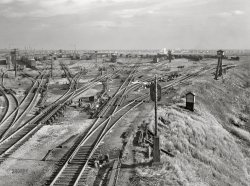
- The Hump Master: 1942
- ... 1942. "Hump master in a Chicago & North Western railroad yard operating a signal switch system which extends the length of the hump ... Posted by Dave - 03/20/2024 - 11:24am -
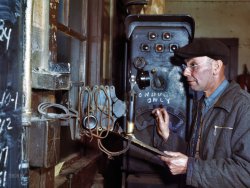
- The Hump Master: 1942
- ... Illinois. Hump master in a Chicago and North Western Railroad yard operating a signal switch system which extends the length of the hump ... Posted by Dave - 03/20/2024 - 11:27am -
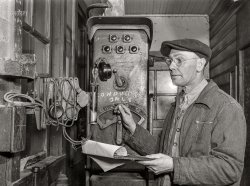
- Boilermakers: 1942
- ... on which they have been working in the roundhouse at a yard of the Chicago and North Western Railroad." Acetate negative by Jack Delano for the Office of War Information. ... Posted by Dave - 03/17/2024 - 3:57pm -
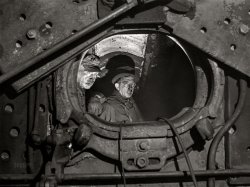
- Frosty Freight: 1942
- ... Looking out toward the icehouse from the freighthouse at a yard of the Chicago and North Western Railroad." Acetate negative by Jack Delano for the Office of War Information. ... Posted by Dave - 03/16/2024 - 8:56pm -
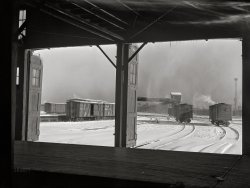
- Illinois Central: 1942
- ... "Chicago, Illinois. Locomotives in an Illinois Central Railroad yard." Medium format acetate negative by Jack Delano for the Office of War ... Posted by Dave - 01/31/2024 - 4:09pm -
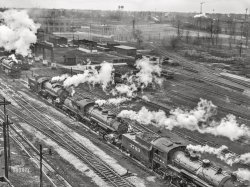
- Trackwork: 1942
- ... crew repairing roundhouse tracks at an Illinois Central Railroad yard." Photo by Jack Delano, Office of War Information. View full size.
... Posted by Dave - 01/17/2024 - 2:55pm -
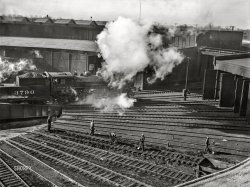
- Engine of Change: 1942
- ... Illinois. In the roundhouse at an Illinois Central Railroad yard. This former switching engine is being rebuilt for use on the road." Medium format acetate negative by Jack Delano for the Office of War Information. View full size.
Kid ... Posted by Dave - 01/08/2024 - 7:29pm -
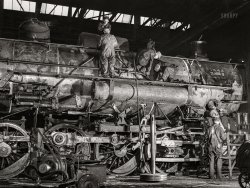
- Proviso Departure: 1943
- ... yards at Chicago & North Western RR's Proviso Yard." 4x5 Kodachrome transparency by Jack Delano for the OWI. View full ... effort.
Proviso Yard Great photo. Amazingly, as railroad locations go this location is remarkably similar today -- Proviso Yard ... Posted by Dave - 07/30/2012 - 10:04pm -
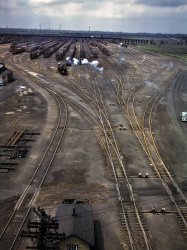
- Amethyst Twilight: 1942
- December 1942. "Proviso departure yard of the Chicago & North Western R.R. at twilight." 4x5 Kodachrome transparency by Jack Delano. View full size.
Fantastic Shot Doesn't matter how it ... my ignorance... I've seen a couple photos on Shorpy of railroad yards that have the same light trails like this one. I'm assuming ... Posted by Dave - 12/15/2016 - 8:07pm -
![Amethyst Twilight: 1942 December 1942. "Proviso departure yard of the Chicago & North Western R.R. at twilight." 4x5 Kodachrome transparency by Jack Delano. View full size.
Fantastic ShotDoesn't matter how it was done, I wouldnt understand it anyway.
trick shot?yeah - i'm a big fan of delano, too...
but..
how'd he manage to have the lantern in the foreground be in sharp focus when it is in a field of soft-focus cinders? odd.
shifted focusExposing for that scene would likely leave the lantern badly over-exposed. I'd bet that the lantern was masked and the focus adjusted mid-exposure.
Perhaps...... my favorite Delano shot ever.
a touch of tiltLooks like he tilted his focal plane to keep the ground in focus off into the distance (note the top of the building is also out of focus)
Forgive my ignorance...I've seen a couple photos on Shorpy of railroad yards that have the same light trails like this one. I'm assuming that they were captured by leaving the shutter open longer (hence the double image of the rail car on the left), but what were they created with? Were they lanterns being carried around? Was this a Jack Delano trademark? In any case, beautiful photo, and one more example I'll be directing people to when I next praise this site.
[Yes, lanterns. - Dave]
Jack's lanternIf you look close you will see two lanters that left the trail of lights....One lantern has a freshers battery in it and thus produces a slightly brighter trail. One man was standing outside the shanty and the other was inside (probably getting a switching list, they both walked to the right where they were probably doing switching.
[The other shots show kerosene lanterns, not battery-powered. - Dave]
Nikon EM can achieve theNikon EM can achieve the same shot with given circumstances
Jack's Lantern"how'd he manage to have the lantern in the foreground be in sharp focus when it is in a field of soft-focus cinders?"
Photoshop maybe?
Just kidding. I'm guessing he did it by tilts.
Could the lantern have been flashing perhaps? This could prevent it from being overexposed. Or perhaps Jack knew when it was turned on and setup the exposure so that the lantern would be switched off for the first portion of the exposure and switched on for the second portion of the same exposure.
this is simply stunning. onethis is simply stunning. one of my favorite photos as well.
Jack DelanoThis is the work of a master. That's obvious, but I had to say it.
LanternThat's a kerosene oil switchlamp. No on/off switch.
The flashing lanternobviously on his other side from the camera.
Stating the obvious, againAll you have to do is do is google "KODACHROME DELANO." Library of Congress has many more. Indeed he was great.
Master of lighting KodachromeJack Delano, wiley photographer. Beautiful image. Most color films tend toward blue with long exposures, with Kodachrome the reciprocity effect goes more toward this gorgeous indigo/violet.
I think this is a double exposure: a short one with the lamp lit and the boxcar nearer (fainter image) and a longer one after the boxcar was moved. If there had been a longer single exposure I would expect the boxcar to show a gradient rather than two states (think of electron field probability diagrams...) He clearly used a small aperture as focus is maintained through a fair depth of field (at least on the longer second exposure). I doubt he used any tilt--not a significant feature on Speed Graphics of the era (I use one), and rise (pretty limited) would not help with the Sheimpflug effect.
(The Gallery, Kodachromes, Chicago, Jack Delano, Railroads)](https://www.shorpy.com/files/images/1a34651u1.thumbnail.jpg)
- Twilight Departure: 1942
- ... December 1942. Chicago, Illinois. "View in a departure yard at Chicago & North Western's Proviso yard at twilight. Brakeman is ... -- guess what -- he shoveled coal into a firebox on the railroad in Seattle for his military service. Thank you, Jack Delano, your ... Posted by Dave - 08/30/2012 - 4:45pm -
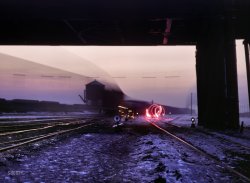
- Pabst Backward: 1943
- ... R.R.: "Pabst Beer sign over the Illinois Central freight yard at South Water Street, Chicago." Kodachrome by Jack Delano. View full ... sound is frequently followed by "aaaaahhhh."
Thirsty Railroad workers on payday I would imagine downed a few of those cold draft ... Posted by Dave - 06/14/2017 - 11:51am -
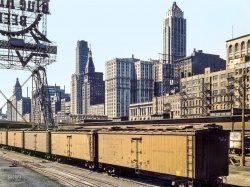
- California Here I Come: 1943
- ... freight about to leave for the West Coast from the Corwith Yard at Chicago. View full size. 4x5 Kodachrome transparency by Jack ... at War" which chronicled this trip and also contained many railroad photos from other parts of the country. The book is out of print but ... Posted by Dave - 07/17/2012 - 10:04pm -
![California Here I Come: 1943 Santa Fe freight about to leave for the West Coast from the Corwith Yard at Chicago. View full size. 4x5 Kodachrome transparency by Jack Delano. This is the freight Jack accompanied from Chicago to California in March 1943, taking many pictures along the way for the Office of War Information.
CaliforniaIs this Delano still alive?
Laurent Wiame from Switzerland...
[Jack Delano died 10 years ago at the age of 83 - Dave]
Thank youThank you for all the amazing color pictures by Jack Delano...
California or BustI hope you have all of the pictures from Frank's trip from Chicago to LA, I certainly would love to see them. So Frank worked for the war dept? He sure was lucky to be able to travel across the country for his job and getting paid for it.
Iron Horse at WarHe wrote a book entitled the "Iron Horse at War" which chronicled this trip and also contained many railroad photos from other parts of the country. The book is out of print but might be found on E Bay. Unfortunately, the book is in Black & White.
That train isn't moving anytime soon!The train still has a blue flag hanging on it. That means that there is still someone working on it. Each worker puts a blue flag on the front end of the train (or on the track ahead of the train) and ONLY that man can remove it. Once all blue flags are removed, the train can then proceed.
Jack DelanoMany thanks for these fabulous photographs. Just stumbled across them ... Delano was an artist of the finest caliber, and you honor him by posting these for future generations to enjoy. Excellent work.
Jack from Chicago
(The Gallery, Kodachromes, Chicago, Jack Delano, Railroads)](https://www.shorpy.com/files/images/1a34699uuu.thumbnail.jpg)
- Pabst Over Chicago: 1943
- ... "South Water Street freight depot of the Illinois Central Railroad, Chicago." 4x5 Kodachrome transparency by Jack Delano. View full ... to the track. Also, note that several of the cars are on "yard air" in order to test the brakes on each car prior to movement. Finally ... Posted by Dave - 05/07/2017 - 2:11pm -
![Pabst Over Chicago: 1943 May 1, 1943. "South Water Street freight depot of the Illinois Central Railroad, Chicago." 4x5 Kodachrome transparency by Jack Delano. View full size.
DirectionalityI believe this photo is facing north. Quite a few of the skyscrapers are still there. All the way to the left, the black & gold building is the Carbide & Carbon (or is it Carbon & Carbide?) building on Michigan Ave. I seem to remember something about it being the "first" skyscraper. Just to the right, with the little cupola on top, is the original Stone Container Building at Wacker & Michigan Avenues. Off in the furthest distance in the center of the photo you can see what was originally called the Pamolive building (it became Playboy Towers, and is now a condo building). I think the building behind the Pabst sign at the right edge of the sign is the Chicago Tribune building, and across from it (underneath the main part of the sign) you can see the white building that is the Wrigley building. They flank Michigan Ave. just north of the Chicago river.
Fellow (ex-)ChicagoanDefinitely facing North, definitely the Carbon & Carbide building - my dad used to have an office there. Not sure about the Playboy Towers.... might that be the Drake Hotel?
33 to 1?Blended 33 to 1? That sounds like a strange formula to me...but of course I'm not informed on the whole beer and beer history thing.
33 to 1Here's a 1940 Pabst ad that explains it.
NorthThere is no question about it, this photo is facing north.
Good Railroad ShotThe blue flags placed on the cars would be a violation of federal regulations today as they now have to be located at the switch providing access to the track. Also, note that several of the cars are on "yard air" in order to test the brakes on each car prior to movement. Finally you can see that this photo provides good images of several different types of car ends all together in one place.
As I am from Milwaukee, I have no clue as to which buildings are which! I do know that the photo is definitely facing north as I now work for the South Shore commuter railroad and am familiar with the lakefront. I also know that the original Santa Fe railroad corporate headquarters was almost directly to the west of this photo and is still there today with the Santa Fe sign on top. It is now an historic landmark.
Bootcamp BeerI went to Navy bootcamp in Great Lakes Il. in 1983 and after spending 10 wks. without beer our first chance to have a brew came. Unfortunatly for me the ONLY beer avaliable to us at the time was Pabst Blue Ribbon. Now, not being a Pabst fan I was very unhappy about that but after 10 tough weeks I said "what the heck" and ordered a couple of beers. I'll tell you what, that was the best beer I've ever had. I got so drunk the rest of the day was blur. I'd like to say "Thanks you Pabst" for the best beer ever and day I don't remember.
Water Street DepotIt appears we are looking north from either Monroe or Randolph. I want to say we're looking from Monroe and that bridge spanning the width of the pic under the sign is Randolph. The row of low-rise buildings on the left side of the pic that are ~6 stories tall and have the water towers on top of them would then be on the east side of Michigan Ave and sitting directly on the north side of Randolph. I believe these trains are in the area east of Michigan Ave and north of Monroe, but south of Randolph as it used to be a railyard (now Millennium Park, north of the Art Institute).
Furthermore there were never any buildings previously on this spot, as it would have either been a rail yard or part of Grant Park (where no buildings were allowed to be built, except for the Art Institute). This leads me to believe that we are looking north from Monroe towards Randolph and beyond. The vast empty space behind the Pabst sign spanning the whole width of the image would now be occupied by Illinois Center, the Prudential Building and of course the tall white AON Building (3rd largest in Chciago at the moment), or whatever they call it these days.
Pabst SignCan anybody tell me if this sign was was animated and are there any night time shots of it?
[The nighttime shot of this neon sign is here. - Dave]
AnimationThanks Dave, do you know if the sign was animated in any way?
[The hands on the clock moved! If you mean did various parts of the sign blink on and off, I don't know. - Dave]
ChicagoI see the tallest building to the far left when I'm going to and from school. It's surrounded by a bunch of other buildings now.
Chevrolet SignThis is a film clip of another Chicago sign. It shows how animated signs were operated. I can't find any date, but the technology looks like 1940 or so.
http://www.encyclopedia.chicagohistory.org/pages/410104.html
Chevrolet SignAfter viewing this clip of the Chevy sign, I'm fairly convinced that it and the 'Pabst' sign are one and the same. Shown in the clip of the Chevy sign is the same tall building that is located to the left of the Pabst sign in the photo. There are other similarities as well, like the circular design of the sign, the clock at the lower right, etc. It's my guess that Pabst took over the sign after Chevy and made the slight changes to suit their logo.
South Water Street TodayThis photo is facing North on South Water Street and intersecting roughly what is now Columbus Drive. The ground level of this photograph is now covered by an elevated roadway in this area. If you went to this spot today, the Pritzker Pavilion at Millennium Park designed by Frank Gehry would be just behind you.
The Playboy Building is visible in the background, now once again called the Palmolive Building and converted to condominiums. It sits between the Drake Hotel and John Hancock Tower at the end of the Magnificent Mile. The Drake is not tall enough to be in view here.
The Allerton Hotel and Northwest University Law School in Streeterville are also visible here, which they wouldn't be today from the site, although they are still standing.
Several of the mid-rise buildings in this photograph are no longer standing, in particular the large red-brick warehouse at the center mid-ground, to the right of the Playboy/Palmolive. This is where the NBC Tower now stands, just north of the river.
Driving and DrinkingThis was indeed the Chevy sign. Pabst took it over. You can still make out the Chevy logo in the superstructure of the sign. The lower left hand corner of the "B" in Blue and the upper right hand corner of the N in "Ribbon" served as the edges of the classic Chevy "bowtie" logo.
Going to ChicagoIt's interesting to think that Muddy Waters would have just arrived in Chicago when this photo was taken.
Pabst signThe Pabst sign was next to Randolph Street Bridge; refer to the 1922 Zoning map that is available at the University of Chicago library site - the Illinois Central may very well have called the yard the 'Water Street Yard,' but Water Street moved to the South Side when Wacker Drive was created after 1924; the Pabst sign was located nearest the Randolph Street bridge and is the current location of the Prudential Building, not the Pritzker Pavillion.
Warehouse full of booksI believe the red brick warehouse-like building on the right (east) of the photo survived into at least the 1980s, serving as the temporary home of the Chicago Public Library's main branch after it moved from what is now the Cultural Center (location of many shots in DePalma's "The Untouchables" and just out of camera range to the left) and before the opening of the Harold Washington Library Center. I used their manual typewriters and xerox machines to peck out and photocopy my resume.
Why Boxcars are blue-flaggedThese boxcars are blue-flagged because they have both their doors open and gangplanks spanning the openings between cars on adjacent tracks. This is also why they are all 40-foot cars and are all lined up with each other.
Less-than-Carload (LCL) freight is being handled here! This something that US railroads have discontinued; for decades, they haven't accepted any shipment less than one car load. As effective highway trucks were developed, they took this trade away from the RR's for obvious reasons.
But, back in the 1940's, RR's would handle a single crate! This required sorting en route, which is what is being done here. There's a large shift of workers shuffling LCL from one car to another by way of the side platforms and the above-mentioned gangplanks.
The LCL required local freight crews to handle this stuff into and out of the freight stations, and required station agents to get the cargo to and from customers, collect charges, etc. Very labor-intensive, yet somehow the trucking companies do it at a profit.
From Pabst To Rolling Rock Beer "33"This photograph has also added another “answer” to the question: “What does the “33” on the label of a bottle of Rolling Rock Beer mean?”
http://www.snopes.com/business/hidden/rolling.asp
One person seeing this photograph concluded on a Rolling Rock Beer forum that the Rolling Rock "33" may have referenced the smoothness of blending “33 to 1.”
http://toms.homeunix.net/toms/locFSA-OWIkodachromes/slides/blended33to1....
Makes you feel like a heroEven now, when I get a color transparency (2 1/4x2 1/4 or 4x5) and look at if for the first time, it is stunning. I can't imagine what it must have looked like to someone seeing it color for the first time ever!
Sign BackgroundIf you look closely at the superstructure of the sign you can see the slogan "Blended 33 to 1" in the framework, which is seen far better in the nighttime shot Dave linked to. As to whether this would be considered animation I don't know, but a typical setup would be to light the Pabst Blue Ribbon sign, then switch to the "Blended" slogan, then light both. Don't know if that was done here.
Those catwalksThe "down-the-throat" shot of those catwalks atop of the freight cars gives the viewer a good idea of what the brakeman had to deal with while setting the brakes. The uneveness of those platforms, even at a standstill, is enough to make the average person think twice about climbing up and traversing these planks. Before airbrakes became the norm, this had to be one of the most harrowing jobs a railroad worker had to face. And this would be on a nice calm day. With rain, wind or snow, even the most seasoned brakeman must've had second thoughts.
Blue Flags?Mr. Leaman pointed out the blue flags were being displayed incorrectly by todays rules. But not being a train enthusiast, what did they indicate in the first place?
Blue-FlaggedAny rolling stock or engine that is "blue-flagged" cannot be moved unless the person who placed the flag removes it. It's a safety rule, and for the protection of the workers, many of whom are between or under the cars.
The iconic "Santa Fe" sign referred to in earlier posts is now on display at the Illinois Railway Museum in Union, IL - not too far from Chicago and well worth the trip!
http://www.irm.org
The early brakeman's plightJKoehler, I read somewhere that a conductor remarked about brakemen in the days when cars used link-and-pin couplers, "If they still have their thumbs after three months, they must be really lazy!"
Phantom Memory of a huge Chicago Phillips 66 Sign?For decades I’ve had a childhood memory of seeing a huge Phillips 66 sign atop the Chicago skyline, while driving with my family in the “wayback” of the family station wagon on the way to visit our grandparents in Iowa. We were coming from Michigan, and driving on Chicago streets because the still-under-construction Interstate Highway System still had gaps. (We were probably driving on/towards westbound US-30.) I remember being in awe of a big neon Phillips 66 sign receding in the distance as my dad drove west. It was a wide straight street, very busy. The sign had lots of neon motion, even in the daylight. This memory (if real), would have been somewhere between about 1963 - 1968. But am I mistaken? Did the Phillips 66 sign never exist, and could this Papst sign be the one I saw?
(The Gallery, Kodachromes, Chicago, Jack Delano, Railroads)](https://www.shorpy.com/files/images/SHORPY-1a34786u3.thumbnail.jpg)
- Proviso Yard, Chicago: 1942
- December 1942. Classification yard at the Chicago & Northwestern Proviso Yard, Chicago. View full size. 4x5 Kodachrome transparency by Jack Delano.
Railyard Technically this railyard is not in Chicago. The ... operate it and did under the watchful eye of various railroad men. If memory is correct there were 9 yards. I did go over the hump ... Posted by Dave - 07/30/2012 - 10:00pm -
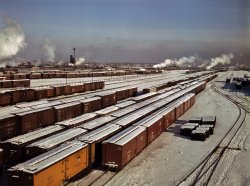
- L. Logan, Boilermaker: 1942
- ... "L. Logan, of West Chicago, boilermaker at the Proviso Yard roundhouse, Chicago & North Western R.R." 4x5 Kodachrome transparency ... He is found in the 1930 Census and was working for the railroad at the time.
Buy him a beer! I wouldn't mind in the least ... Posted by Dave - 08/06/2012 - 10:58pm -
![L. Logan, Boilermaker: 1942 December 1942. Melrose Park, Ill. "L. Logan, of West Chicago, boilermaker at the Proviso Yard roundhouse, Chicago & North Western R.R." 4x5 Kodachrome transparency by Jack Delano, Office of War Information. View full size.
IncredibleWhat a face!! He has not had an easy life. He looks weary.
Startling, lifelike!Wow, it's like looking through a window directly into the past.
A fantastic portraitBut then again I find most of Jack Delano's work to be amazing. You can almost smell the oil, sweat and coal dust.
Those spectaclesIt seems as though his glasses might fit quite snug under those goggles.
I can smell the welding now.
Reminds me of my old tradesmanThis bloke looks a lot like the first tradesman I was assigned to when I was an apprentice boilermaker. Happy memories!
You know JackJack Delano is one of the great photographers who need not sign his work.
You know who took that photograph that just knocked you off your feet!
Whatta guy!
Great LightingAnother fantastic Jack Delano photo. The lighting really brings out the character in his face.
When I first saw the photo I thought I was looking at Henry Fonda.
Delano's workcould be the inspiriation for the super-realism artists. Delano creates with photography what those guys do with an airbrush.
Leroy LoganBased on my research, I am fairly confident that this is Leroy Logan, born circa 1889 in Illinois. He is found in the 1930 Census and was working for the railroad at the time.
Buy him a beer!I wouldn't mind in the least buying this man a drink and talking shop with him.
[I'd buy him a boilermaker. - Dave]
MaybeI grew up in West Chicago, which was a fairly small town when that photo was taken, maybe 5000 people at most. Chances are good I crossed paths with him or more than likely his kids. He looks like a hard working good guy.
FlawlessI think this is the finest exposure on the whole site, to date. Great composition and lighting. Delano's masterpiece, perhaps, and shows how amazing Kodachrome could be. (I used it exclusively, even for night shots with that slow 16 and 25 ASA, even if I had to sit for hours waiting for an exposure.)
Stay Bolt InspectionThis gentleman is likely conducting inspection or repair of stay bolts inside a radial stay fire box. He's crawling (or peeking) out of an open butterfly fire box door. He appears to have air lines under his left glove for tools. Stay bolts keep the boiler in perfect radius around the fire box and are hollow so that when tested under pressure they leak and water can be detected on close inspection. A leaking stay bolt must be ground out and replaced. A deafening and dirty job.
Shift ShaveFrom the stubble on his face, I would guess this was well into a long shift. Mr. Logan looks like a gentleman who started his shifts with a clean shave.
If the hat fits.....That is certainly a very well-worn and stained Fedora that Leroy is wearing.....probably his favourite work-hat.
I'll bet that it has seen a few years since it left the manufacturers.
Firebox Door!That's it! I was trying to figure out exactly where Mr. Logan was on the locomotive. Not many clues here but I figured the castellated nut above his head is the pivot point of a "Butterfly" firebox door on the boiler backhead. The angled pipe to the left was used to open and close the door manually and on most engines there was also a foot pedal to open the door automatically for "hand firing." You can see part of the flue sheet inside the firebox above his right ear. Jack took the picture from the cab floor.
(The Gallery, Kodachromes, Jack Delano, Railroads)](https://www.shorpy.com/files/images/SHORPY_1a34673u.thumbnail.jpg)
- The Red Caboose: 1943
- ... touches on a rebuilt caboose on the rip tracks at Proviso Yard, Chicago. April 1943. View full size. 4x5 Kodachrome transparency by ... track or tracks in a rail yard where locomotives and/or railroad cars are set out for minor repairs without removing the units from ... Posted by Dave - 07/30/2012 - 10:02pm -
![The Red Caboose: 1943 Chicago & North Western RR worker putting the finishing touches on a rebuilt caboose on the rip tracks at Proviso Yard, Chicago. April 1943. View full size. 4x5 Kodachrome transparency by Jack Delano.
CabooseGreat photo, Jack takes really terrific RR pictures, has he ever contributed to Trains or Railfan magazines?
[This picture is over 60 years old ... Jack died 10 years ago at the age of 83. - Dave]
KodachromeEarly Kodachrome looked so good. Color film these days has too much contrast.
Re: Kodachromeyes, i have noticed most of the pictures taken in the 40s that i have seen on this site are more crisp than the ones taken now!
American railway jargon is aAmerican railway jargon is a bit of a mystery to me. Can you tell me what "rip tracks" are?
Rip tracksRIP track
From Wikipedia, the free encyclopedia
A RIP track (RIP is an acronym for repair in place) is a designated track or tracks in a rail yard where locomotives and/or railroad cars are set out for minor repairs without removing the units from service, sometimes without even removing a freight load from the car. In some yards, a RIP track may be used for staging locomotives or "bad order" cars for major repairs. Some yards may have more than one RIP track to serve both functions.
Jack DelanoJack Delano was not a railfan per se. I am not sure he was even particularly a photographer by trade. He was a beneficiary of government funds during the FDR era. Fortunately he was sensitive to the drama of the railroads.
Interestingly, some years ago I attended a concert by a Cuban clarinet / saxophone player named Paquito d'Rivera. The music was more or less jazz/classical fusion and one of the pieces was composed by Jack Delano, who moved to Puerto Rico after the war. So Delano was a true artist in more ways than one.
Dave Nelson
(The Gallery, Kodachromes, Chicago, Jack Delano, Railroads)](https://www.shorpy.com/files/images/1a34685u_0.thumbnail.jpg)
- The Hump Office: 1942
- ... to the hump office at a Chicago & North Western railroad yard, Chicago." 4x5 Kodachrome transparency by Jack Delano for the Office of ... Posted by Dave - 01/16/2014 - 6:12pm -
![The Hump Office: 1942 December 1942. "Switch lists coming in by teletype to the hump office at a Chicago & North Western railroad yard, Chicago." 4x5 Kodachrome transparency by Jack Delano for the Office of War Information. View full size.
The List - Railroad Abbreviations?I can figure out some of the abbreviations in the left column as railroads: SFE = Santa Fe, RDG = Reading, PA = Pennsylvania, NYC = New York Central, RI = Rock Island, MIL = Milwaukee Road. Maybe someone out there can figure out the others: CIM, MP, EJE, COFG, GCX, UTLX, CNW, MDT. I also think the ones in the center column are abbreviations (BELT, PENNA, IHB, IHLOC, CBQ), but of railroads or cities?
20 Years Later...in 1962, a similarly attired C+O clerk, leaning back in a swivel chair, feet up on the console of the Univac 1 at Case Tech, watching the neon lights blink and the metal tapes spin.
C+O's corporate offices were in the Terminal Tower, and a clerk came out to Case every day to run accounting jobs. This was the only use the Univac 1 got at the time, with the Burroughs 220 and the new Univac 1107 taking over student class load.
My phone has more computing power than all of them put together.
Could it be?General MacArthur above the pictured man's head?
[Good catch! Time magazine, December 29, 1941. -tterrace]
The ListClick to enlarge.
Railroad AbbreviationsCIM = Chicago, Illinois, and Midland
MP = Missouri Pacific
EJE = Elgin, Joliet, and Eastern
COFG = Central of Georgia
GCX = General Chemical
UTLX = Union Tank Car Co.
CNW = Chicago & Northwestern
MDT = Merchants Despatch Transportation
Full disclosure: Other than CNW, I had to rely on the magic of the interwebs.
Hump listThe list most likely represents train 284 out of Butler Yard (Milwaukee, Wisconsin) on the Wisconsin Division, with conductor GL Stewart in charge. The 1, 2, 3...designation indicates the first car to go over the hump, the second, etc.
I find in interesting that the official reporting marks of the various railroads are not used. Regarding bigguy1960’s question: CIM represents the Chicago and Illinois Midland railroad. MP represents the Missouri Pacific railroad, often called the Mopac. EJE represents the Elgin Joliet and Eastern railroad, owned by US Steel at the time to handle their product. MDT stood for Merchants Despatch (the “e” is correct) Transportation. CNW was the Chicago and Northwestern railroad, the host railroad for the picture. The X designation in a reporting mark meant the rail equipment was owned by a company other than a railroad. Hence, UTLX refers to the Union Tank Car Company, still with us today.
The “COFG” and “GCX” have me stumped.
The two character designation to the right of the initial/number represents load or empty, and car type. X stands for empty, thus CIM 5449 is an empty “gon,” or gondola. Lines three and four are empty hoppers. Lines 14, 15, 16, 20, 21, 22 and 23 are loads, with a brief description of the lading.
The next block of information indicates which railroad in Chicago the car goes to. The line one through six block will go to the BRC, the Belt Railroad of Chicago. The handwritten twos and sixes are for the pin puller on the hump. He will see a block of six cars and pull the pin “behind six,” instead of scrutinizing each car reporting mark and number.
The two digit number to the right of the off going line represents the cars weight, critically important to the retarder operator. A couple of the cars show “10” tons, and I’m assuming they are wooden sided gons, which would account for their very light relative weight.
Let's dissect a switch listThe very top of the page shows the train's origin and date.
1. The left column is the position number of the car in the train followed by the car initials and number. The double letter indicates car type, i.e.XG, gondola; XM, boxcar, etc.
2. The next column lists the car destination as far as this yard is concerned. Belt would be Belt Railway of Chicago; IHB is Indiana Harbor Belt, with initials after indicating IHB's connecting destination, for instance CBQ is Burlington Route. Most of this train is being delivered to C&NW's connecting railroads in the neighborhood.
3.Third column of typed numbers is the track number the car is headed for. The hand written number shows multiple car cuts. To the right of the track numbers is any special notations or instructions. It looks like "Ride" is the big note, meaning the car should be ridden by a trainman off the hump, to slow the car to prevent damage to lading.
In this time, most humps employed "hump riders", trainmen who controlled speed of cars as they rolled into the tracks by gravity after being uncoupled in motion.
Early in my career, only the yard conductor got a nice printout like this. He would scribble out a simple switchlist for his trainmen that only listed how many cars to which track number. The conductor was the only one who had car numbers to work with; if he missed an extra car, or a car missing, all the work beyond that was wrong and had to be straightened out. (Most guys were careful about that.)
Couple more abbr.BELT = Beltline RR (Chicago local freight)
CBQ = Chicago Burlington & Quincy (Burlington route)
Those Initials and moreCOFG = Central of Georgia (Railroad)
GCX = General Chemical (Company)
WAB - Wabash (Railroad)
The Belt (Railway Company of Chicago) gets all of its empty Railroad owned cars on the same Track 28, but the PENNA (Pennsylvania Railroad) gets its empty PA (Pennsylvania Railroad) cars on Track 10 and an empty RDG (Reading Railroad) car on Track 9.
Thanks, SHORPYAnother learning experience thanks to your superb members.
(The Gallery, Kodachromes, Chicago, Jack Delano, Railroads)](https://www.shorpy.com/files/images/SHORPY_1a34624u.thumbnail.jpg)
- Locomotive Dreams: 1942
- Roundhouse at the Chicago and Northwestern Railroad yard, Chicago. December 1942. View full size. 4x5 Kodachrome transparency ... Posted by Dave - 07/24/2012 - 11:29pm -
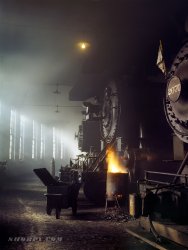
- Trucks Akimbo: 1939
- ... is in really sharp focus.
Great Northern Freight Yard I believe this is one of the freight houses behind the GN depot in ... Station" belonged to the Chicago & North Western Railroad on Fourth Avenue North near First Street. The building still survives, ... Posted by Dave - 09/13/2011 - 8:18pm -
![Trucks Akimbo: 1939 September 1939. "Minneapolis, Minnesota. Trucks loading at farm implement warehouse." 35mm nitrate negative by John Vachon. View full size.
Looks like scale models in a set.Particularly everything from the train tracks up. The lower section doesn't have the sheen or something to carry it off.
The two guys in and around the truck don't help either.
I wondered at firstLooking at the top half of the picture I almost thought it was one of those amazingly detailed models we see occasionally, but then I saw the guy hanging out of the truck window bottom left!
ToysThis looks like a bunch of toys. If only it was also a tilt/shift photograph.
Traffic JamLooks like a game of Traffic Jam with 30's vehicles.
ModelesqueI know the photo is real, but it looks like one of Michael Paul Smith's images.
Tonka! This so looks like a kid's play area with all his little cars and trucks. Hope he isn't in the mood for an accident.
Slightly SurrealThere is a definite air of artificiality here, in spite of the fact that this
is an authentic photograph of a real-life scene. Is it the rakish angle?
The floating-above-it-all perspective? It screams "scale model" as in
a contrived cityscape in a model-enthusiast's basement.
1934Never mind the big Minneapolis truckers strike in 1934, in which the National Guard was called in to shoot the strikers in the streets. It's a big deal in Labor history, particularly in Minnesota. But have fun with it.
Doublemint twinsI had no idea their ad concept went back that many years.
The year before I was born!Amazing that this was possible with 35mm, but if you examine the photo carefully you wil see that only the truck in the upper center is in really sharp focus.
Great Northern Freight YardI believe this is one of the freight houses behind the GN depot in Minneapolis. The yard was bisected at 4th Avenue North, where I think the 1939 photo was taken. There is one remaining building that is today used for housing.
Don't pass on the rightI found it interesting that the truck crossing the tracks only had a mirror on the right side. I though that may have been a traffic hazard till I noticed that none of the many vehicles had side mirrors at all!
WOW, Clean!!!!I am amazed at how clean this area and the trucks appear. Very little litter laying around and absolutely ZERO graffitti. Of course the spray paint can wasn't invented yet.
Batman!This totally looks like a panel from a Batman comic.
AkimbophileGood to be able to use a word like "akimbo" any time. A wonderful word that is perfect. It just rolls off the tongue so nicely. And works well in Scrabble at times.
City lifeCity life in the forties. Cars and trucks had awesome designs.
MatchboxesLooks like somebody's Matchbox collection in an HO scale layout.
A guessSomehow I think the guy hanging out of the window in the truck in the center of this started off his conversation with "Hey Lou!"
DizzyThe angle of the shot actually makes me dizzy.
Or the Untouchables!Which truck has the booze, and will Ness find it in time? They'll be headed back to the border for more if he doesn't!
Something's FishyOkay, I'll stick my neck out. I think these are scale models; cars, trucks and building. The vehicles are all too clean and perfect. No loading docks in sight, nor one human. That was my first impression yesterday and it's still my impression today.
[There are at least five people in the photo. - Dave]
Science is Helpless Also looks like a miniature set from a "Beast From 20,000 Fathoms" type movie. I'm waiting for a lizard to stomp on some of these cars and trucks.
Dioramais what this almost looks like except the people and the papers in the gutter say otherwise.
SurrealThis picture has an otherworldly quality, particularly when one views the full size version. The angles are unsettling and chaotic, and the vehicles begin to look like tiny toy model versions of their real selves. It's like a noir version of the intro to "Mister Rogers' Neighborhood." One almost expects to see John Garfield step out of that doorway.
"Wheeler"Now there's a perfect name for a transportation company.
Fourth AvenueThe "Freight Station" belonged to the Chicago & North Western Railroad on Fourth Avenue North near First Street. The building still survives, although has no railroad track anymore. Angle of the photo suggests it was shot from the roof of long-gone Security Warehouse.
1. A 1982 view.
2. Bird's eye view.
I see I'm not the only one that sees this as a model. So I looked at the image again and came up with some reasons why I think it looks like a miniature.
The angle of the camera doesn't seem to have any effect on the miniature. I rotated it, and still looks small.
I think the main reason is the lack of any harsh shadows and bright highlights. It could be early morning, or a cloudy day. A couple of trucks in the foreground do have sun on them, and the illusion seems to fail there. The way the cars are parked may have something to do with it. They are not perfectly parked by today's standards, and the guy on the sidewalk is asking for a ticket. The softness of the details in the above half also lend to the fact that the cars look die cast, and lacking in detail of a full size auto. Lastly, the angle of the shot is from somewhat of a humans eye view if they were looking down onto a table top. That's about it.
Supreme exampleAfter New York's police commissioner banned trucks with advertising sideboards (like the Doublemint ad on the Railway Express truck in lower right), Railway Express Agency tried but failed to convince the U.S. Supreme Court to overturn the regulation. In the 1948 decision, Justice Douglas added that "the fact that New York City sees fit to eliminate from traffic this kind of distraction, but does not touch what may be even greater ones in a different category, such as the vivid displays on Times Square, is immaterial."
C&NW Freight StationThe "Freight Station" is the building seen on the right in this Street View. Below that is another shot by John Vachon of the same scene.
View Larger Map
Memo to the "model" crowdTo avoid further embarrassment you might want to check out the other pics in this series.
John VachonShorpy-ites will be gratified to know that a book of John Vachon's photos was just added to the Library of Congress's excellent "Fields of Vision" series--along with Esther Bubley and Jack Delano!
Not a modelTook me a while, but before I looked at the other pictures I decided that while the angle certainly helps mess things up, what really got me was that the sizes of the trucks in comparison to that of the cars are smaller than they are today. I'm used to seeing trucks that are wider, or longer, or both. The "Wheeler Transportation" truck is what starts the whole "it's a model!" thing off for me. It looks like it doesn't belong, and, therefore, nothing else does, either.
At least until you look at the detail of the street cobbles, the weathering on the wheels, and etc., that is.
The Jack Greaves truck is the weirdest, with a bed that looks like a model bed, a person in the window that could go either way, but wheels that look like they are carrying a truck's worth of weight, which is something you never see in models.
Weird.
Shifty lookThe out-of-focus, tilt-shifty look in many of the pictures taken with these early 35mm Leicas was due to the film not being in entirely the focal plane. You had to be very careful loading. A redesign of the camera back around 1940 took care of the problem.
Real PeopleI am not certain how you all believe that this can be a model with those people in the picture. Sure, it looks a bit like toys but the people are hard to fake.
DoublemintLove the early Otis Shepard Doublemint gum billboard.
Otis Shepard's Doublemint twinsI love the Otis Shepard illustration on the side of the truck, too. I don't have an image of that particular one, but I do have color images of two others from the same campaign:
RE: Fourth AvenueThe building labeled "Freight Station" still exists and is residential. The building just out of the frame on the left side is the original Lindsay building, also now residential.
It's lowest level can be seen in the photo added by "Anonymous Tipster" on 5/20/2010.
RE: johnhill_3009 on Tue, 05/18/2010
The Security Warehouse building is still very much standing today (and yes, residential). Unless there was another building named Security Warehouse, it's much too far away (about 250 yards) to provide that perspective.
(The Gallery, Cars, Trucks, Buses, John Vachon, Minneapolis-St. Paul)](https://www.shorpy.com/files/images/8a04680u.thumbnail.jpg)
- Locomotive Lair: 1942
- December 1942. "In the roundhouse at Proviso Yard, Chicago & North Western Railroad. Chicago, Illinois." Nitrate negative by Jack Delano, Office of War ... Posted by Dave - 08/12/2022 - 11:01am -
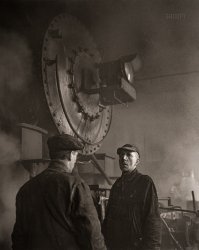
- 40th Street Yard: 1942
- ... sand and water at the coaling station in the 40th Street yard of the Chicago & North Western R.R." Kodachrome transparency by Jack ... "40th Street Yard" might lead one to think that this railroad facility was located on the South Side of Chicago, where all the ... Posted by Dave - 05/19/2017 - 12:24pm -
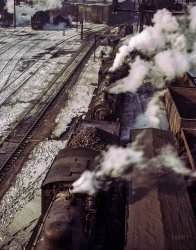
- Yardman: 1942
- December 1942. "Chicago, Illinois. In the Proviso Yard roundhouse, Chicago & North Western Railroad." Nitrate negative by Jack Delano for the Office of War Information. ... Posted by Dave - 08/11/2022 - 5:33pm -
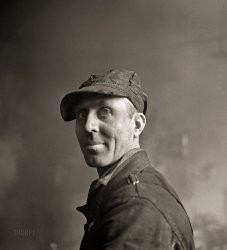
- Barstow Yard: 1943
- ... General view of the Atchison, Topeka & Santa Fe yard." Photo by Jack Delano, Office of War Information. View full size.
... in the war effort I'm really surprised. Most period railroad photos show huge amounts of foreign road equipment and even in the ... Posted by Dave - 12/21/2012 - 7:49am -
